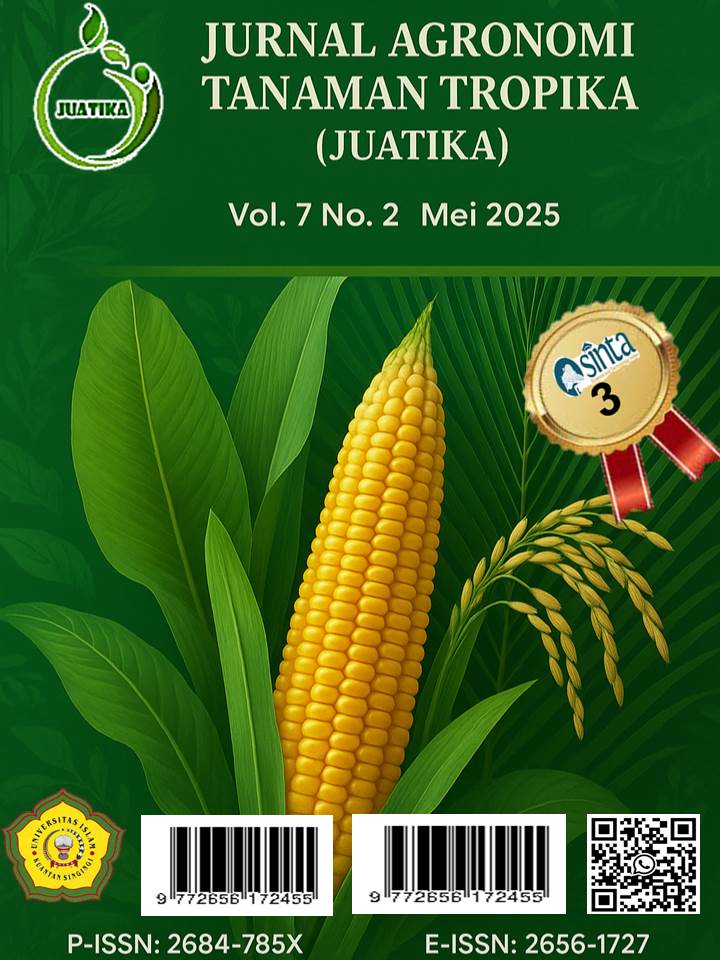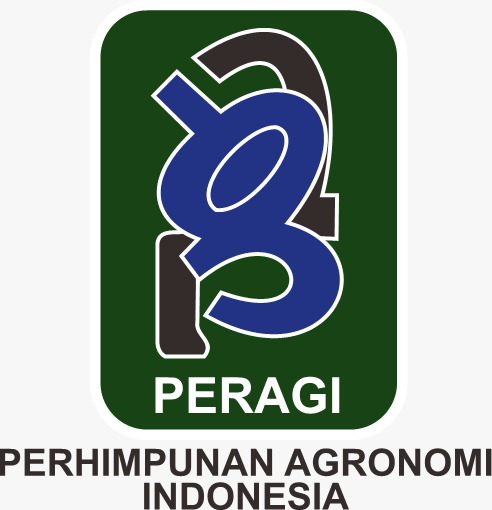Differences in Soil Nutrient Levels in Oil Palm Plantations (Elaeis guineensis Jacq.) Planting Age 6 and 8 Years
-
Abstract
Oil palm plantations in Riau Province were commonly found on suboptimal lands, such as Inceptisol soils, which exhibited inherently poor soil chemical fertility. This research aimed to determine the chemical properties of Inceptisol soil in 6- and 8-year-old oil palm plantations. This research was conducted from July to December 2024 at the Oil Palm Plantation, Sub-District Perhentian Raja, Kampar District, Riau. The analysis of soil chemical properties was carried out at the Instrumental Chemistry Laboratory, Faculty of Mathematics and Natural Sciences, Padang State University. This research employed a quantitative descriptive method, where data collection was conducted through direct observation and subsequently analyzed in the laboratory. A purposive sampling technique was employed to collect soil samples, where each block was divided into four sampling plots. Within each plot, soil samples were collected and composited from five sub-samples, yielding a total of eight Inceptisol soil samples for subsequent analysis. The following soil parameters were analyzed: pH (H2O), OC, total N, P, K, Ca, Mg, SO4, and CEC. The chemical properties of the Inceptisol at the research sites were characterized by: a pH range of very acidic to acidic, sufficient levels of OC, and total-N, very low levels of total (P and K), excessive of total-Ca, deficient of total-Mg, very low levels of SO4, and moderate to high levels of CEC; there were significant mean differences in soil N, SO4, and CEC, whereas soil pH, OC, P, K, Ca, and Mg levels were not influenced by oil palm age.
Downloads
References
Andriany, Fahruddin, & Abdullah, A. (2018). Pengaruh jenis bioaktivator terhadap laju dekomposisi seresah daun jati Tectona grandis L. F., di wilayah Kampus Unhas Tamalanrea. Bioma: Jurnal Biologi Makassar, 3(2), 31–42.
Aspel, C., Murphy, P. N. C., McLaughlin, M. J., & Forrestal, P. J. (2021). Sulfur fertilization strategy affects grass yield, nitrogen uptake, and nitrate leaching: A field lysimeter study. Journal of Plant Nutrition and Soil Science, 185(2), 209–220.
Azmi, C. U., Zuraida, Z., & Arabia, T. (2022). Beberapa sifat kimia Inceptisol yang disawahkan satu dan dua kali setahun di Kecamatan Linge Kabupaten Aceh Tengah. Jurnal Ilmiah Mahasiswa Pertanian, 7(3), 467–476.
Balai Pengujian Standar Instrumen Tanah dan Pupuk. (2023). Petunjuk teknis ed. 3: Analisis kimia tanah, tanaman, air dan pupuk. Diunduh 20 September 2024, dari https://tanahpupuk.bsip.pertanian.go.id/berita/juknis-analisis-kimia-edisi-3-acuan-prosedur-analisis-tanah-tanaman-air-dan-pupuk/
Beyene, A., Tesfaye, Y., Tsige, D., Sorsa, A., Wedajo, T., Tesema, N., & Mekuria, G. (2022). Experimental study on potential suitability of natural lime and waste ceramic dust in modifying properties of highly plastic clay. Heliyon, 8, 1–13.
Bing, J., Wu, K., Zhang, G., Rositter, D. G., & Li, L. (2017). Characterization of some calcareous soils from Henan and their proposed classification in Chinese Soil Taxonomy. Pedosphere, 27(4), 758–768.
Chaudhry, A. H., Nayab, S., Hussain, S. B., Ali, M., & Pan, Z. (2021). Current understandings on magnesium deficiency and future outlooks for sustainable agriculture. International Journal of Molecular Sciences, 22, 1–18.
Direktorat Jenderal Perkebunan. (2023). Statistik Perkebunan Jilid I 2022–2024. Diunduh 8 Juni 2024, dari https://ditjenbun.pertanian.go.id/?publikasi=statistik-perkebunan-jilid-i-2022-2024
Farhat, N., Sassi, H., Zorrig, W., Abdelly, C., Barhoumi, Z., Smaoui, A., & Rabhi, M. (2015). Is excessive Ca the main factor responsible for Mg deficiency in Sulla carnosa on calcareous soils? Journal of Soils and Sediments, 15, 1483–1490.
Farrasati, R., Pradiko, I., Rahutomo, S., Sutarta, E. S., Santoso, H., & Hidayat, F. (2019). C-organik tanah di perkebunan kelapa sawit Sumatera Utara: Status dan hubungan dengan beberapa sifat kimia tanah. Jurnal Tanah dan Iklim, 43(2), 157–165.
Food and Agriculture Organization. (1980). Soil and plant testing and analysis (FAO Soils Bulletin). Rome: FAO.
Hadi, M. A., Razali, & Fauzi. (2015). Pemetaan status unsur hara fosfor dan kalium di perkebunan nanas (Ananas comosus L. Merr) rakyat Desa Panribuan Kecamatan Dolok Silau Kabupaten Simalungun. Jurnal Agroekoteknologi, 2(2), 427–439.
Harahap, A. A., Idwar, O., Oktorini, Y., Qomar, N., Darlis, V. V., & Pebriandi. (2022). Identifikasi sifat fisik tanah Inceptisol pada penggunaan lahan (land used) di sekitar kawasan Kampus Bina Widya Universitas Riau. SYLVA: Jurnal Penelitian Ilmu-Ilmu Kehutanan, 11(2), 58–65.
Johan, P. D., Ahmed, O. H., Omar, L., & Hasbullah, N. A. (2021). Phosphorus transformation in soils following co-application of charcoal and wood ash. Agronomy, 11(10), 1–25.
Kaiser, D. E., & Vetsch, J. A. (2024). Sulfur for Minnesota soils. Diunduh 5 April 2025, dari https://extension.umn.edu/micro-and-secondary-macronutrients/sulfur-minnesota-soils
Kong, X., Li, D., Song, X., & Zhang, G. (2021). Quantitative estimation of the changes in soil CEC after the removal of organic matter and iron oxides. Agricultural Sciences, 12, 1244–1254.
Kowalska, J. B., Zaleski, T., Jozefowska, A., & Mazurek, R. (2019). Soil formation on calcium carbonate-rich parent material in the Outer Carpathian Mountains – A case study. Catena, 174, 436–451.
Liang, J., Liu, J., Jia, P., Yang, T., Zeng, Q., Zhang, S., Liao, B., Shu, W., & Li, J. (2020). Novel phosphate-solubilizing bacteria enhance soil phosphorus cycling following ecological restoration of land degraded by mining. ISME Journal, 14, 1600–1613.
Lubis, N., & Sebayang, N. U. W. (2024). Effect doses level of vermigot fertilizer on the chemical and biological characteristics of Inceptisol and maize (Zea mays L.) production. BIO Web of Conferences, 99, 1–8.
Luo, Y., Shi, C., Yang, S., Liu, Y., Zhao, S., & Zhang, C. (2023). Characteristics of soil calcium content distribution in karst dry-hot valley and its influencing factors. Water, 15(6), 1–13.
Malesi, W. A. W., Yusuf, M. A., Parjono, & Rupang, M. S. (2023). Kajian sifat kimia tanah sawah pada beberapa lokasi di Distrik Semangga. Jurnal Agriment, 8(1), 60–64.
Musinguzi, P., Ebanyat, P., Tenywa, J. S., Basamba, T. A., Tenywa, M. M., & Mubiru, D. N. (2016). Critical soil organic carbon range for optimal crop response to mineral fertilizer nitrogen on a Ferralsol. Experimental Agriculture, 52(4), 1–19.
Ningsih, R. C., Nusantara, R. W., & Manurung, R. (2024). Karakteristik kimia tanah pada beberapa penggunaan lahan di Desa Lumut Kecamatan Toba Kabupaten Sanggau. Jurnal Pedontropika: Jurnal Ilmu Tanah dan Sumber Daya Lahan, 10(1), 50–55.
Noto, E. P., Foster, H. L., & Nelson, P. N. (2023). Potassium and magnesium uptake and fertiliser use efficiency by oil palm at contrasting sites in Sumatra, Indonesia. Nutrient Cycling in Agroecosystems, 126, 263–278.
Novansius, Kautsar, V., & Hartati, R. M. (2023). Respons pertumbuhan bibit kelapa sawit terhadap pemberian dolomit dan tanah gambut sebagai campuran media tanam pada Podsolik Merah Kuning di pembibitan main nursery. Agroforetech, 1(2), 978–982.
Nurlaila. (2017). Analisa kandungan nitrogen pada lahan setelah penanaman Leguminosae cover crop. Jurnal Agriment, 2(2), 1–4.
Paramisparam, P., Ahmed, O. H., Omar, L., Ch’ng, H. Y., Johan, P. D., & Hamidi, N. H. (2021). Co-application of charcoal and wood ash to improve potassium availability in tropical mineral acid soils. Agronomy, 11, 1–30.
Punuindoong, S., Sinolungan, M. T. M., & Rondonuwu, J. J. (2021). Kajian nitrogen, fosfor, kalium dan C-organik pada tanah berpasir pertanaman kelapa Desa Ranoketang Atas. Soil Environmental, 21(3), 6–11.
Purba, T., Ningsih, H., Purwaningsih, Junaedi, A. S., Gunawan, B., Junairiah, Firgiyanto, R., & Arsi. (2021). Tanah dan nutrisi tanaman. Yayasan Kita Menulis, Medan.
Purwanto, T., Jaya, A., Widiastuti, Birawa, C., Adji, F. F., & Anwar. (2019). Kajian erosi, aliran permukaan dan kehilangan hara pada tanaman kelapa sawit dengan umur yang berbeda (Study of erosion, runoff and nutrient losses from oil palm plantation with different ages). https://doi.org/10.36873/agp.v20i02.143
Reicks, S. (2021). Potassium behaviour in soil. Diunduh 12 Februari 2024, dari https://www.pioneer.com/us/agronomy/potassium-behavior-soil.html
Richards, I. (2017). Magnesium as a nutrient for crops and grass. Diunduh 10 Februari 2024, dari https://www.pda.org.uk/magnesium-nutrient-crops-grass/
Sanputawong, S., Chansathean, K., Peakchantuk, N., & Chuiruy, C. (2017). Study of proper fertilizer management on growth and yield of oil palm (Elaeis guineensis Jacq.). International Journal of Agricultural Technology, 13(7), 2631–2639.
Sinaga, F., Sopandie, D., & Santosa, E. (2024). Pengelolaan pemupukan kelapa sawit (Elaeis guineensis Jacq.) di Kebun Aek Nabara, Sumatera Utara. Buletin Agrohorti, 12(3), 366–374.
Suhemi, R., Hayati, & Nusantara, R. W. (2022). Status kesuburan tanah Inceptisol pada penggunaan lahan kelapa sawit di Desa Pengadang Kecamatan Sekayan Kabupaten Sanggau. Pedontropika, 8(2), 25–35.
Sumarni, S., Rosdiana, R. H., & Saputra, O. (2020). Studi habitat dan pola persebaran belimbing darah (Baccaurea angulata) pada kawasan berhutan di Desa Pelimping Kabupaten Sintang. Piper, 16(30), 40–51.
Suryani, I., Nontji, M., & Julita, N. (2022). Morphological characteristics and classification of Inceptisol in Mamuju Regency, West Sulawesi. IOP Conference Series: Earth and Environmental Science, 807(4), 1–9.
Taalab, A. S., Ageeb, G. W., Siam, H. S., & Mahmoud, S. A. (2019). Some characteristics of calcareous soils: A review. Middle East Journal of Agriculture Research, 8(1), 96–105.
Viégas, I. J. M., Souza, L. C., Ferreira, E. V. O., Costa, M. G., Nogueira, G. A. S., Nascimento, V. R., & Neto, C. F. O. (2024). Changes in calcium accumulation and utilization efficiency and their impact on recycling, immobilization, and export across the oil palm cycle. Oil Crop Science, 9, 143–150.
Winarso, S. (2005). Kesuburan tanah: Dasar kesehatan dan kualitas tanah. Gava Media.
Zhao, J., Li, C., Lu, C., Deng, L., Liu, G., & Fan, M. (2022). Acidic condition accelerates cation release from purple rock in Southwestern China. Scientific Reports, 12, 1–11.
Copyright (c) 2025 Oksana, Riska Dian Oktari, Arya Wirandanu

This work is licensed under a Creative Commons Attribution 4.0 International License.
Authors who publish with Jurnal Agronomi Tanaman Tropika (JUATIKA) agree to the following terms:
Authors retain copyright and grant the Jurnal Agronomi Tanaman Tropika (JUATIKA) right of first publication with the work simultaneously licensed under a Creative Commons Attribution License (CC BY 4.0) that allows others to share (copy and redistribute the material in any medium or format) and adapt (remix, transform, and build upon the material for any purpose, even commercially) with an acknowledgment of the work's authorship and initial publication in Jurnal Agronomi Tanaman Tropika (JUATIKA).
Authors are able to enter into separate, additional contractual arrangements for the non-exclusive distribution of the journal's published version of the work (e.g., post it to an institutional repository or publish it in a book), with an acknowledgment of its initial publication in Jurnal Agronomi Tanaman Tropika (JUATIKA). Authors are permitted and encouraged to post their work online (e.g., in institutional repositories or on their website) prior to and during the submission process, as it can lead to productive exchanges, as well as earlier and greater citation of published work.







 More Information
More Information



